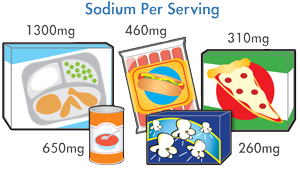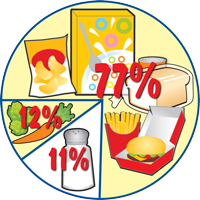Food
Sodium in Your Diet: Using the Nutrition Facts Label to Reduce Your Intake
 |
|
Available in PDF (2.24MB).
También disponible en Español (Spanish).
 You’ve probably heard that most Americans eat too much salt. Salt contains sodium and too much sodium can raise blood pressure – which can have serious health consequences if not treated.
You’ve probably heard that most Americans eat too much salt. Salt contains sodium and too much sodium can raise blood pressure – which can have serious health consequences if not treated.
Despite what many people think, use of the salt shaker is not the main cause of too much sodium in your diet. In fact, over 75% of dietary sodium comes from eating packaged and restaurant foods.
The Nutrition Facts Label on food and beverage packages is a useful tool for making healthful dietary choices and monitoring how much sodium is contained in a food you are considering.
Full nutrition labeling is not required of restaurants for their menu items, unless nutrient claims are made, such as “Low Sodium” or “Low Fat.” So, you may not learn how much sodium is in a food unless you ask.
Check the Label!
High levels of sodium may seem “hidden” in packaged food, particularly when a food doesn’t “taste” salty – but sodium is not hidden on the Nutrition Facts Label!
The Nutrition Facts Label lists the Percent Daily Value (%DV) of sodium in one serving of a food.
The %DV for sodium is based on 100% of the recommended amount of sodium, which is less than 2400 milligrams (mg) per day.
The %DV listed is for one serving, but many packages contain more than one serving! Look at the serving size and how many servings you are actually consuming – if you eat two servings you get twice as much sodium (or double the %DV).
Use the Percent Daily Value (%DV) to Compare Products
The %DV tells you whether a food contributes a little or a lot to your total daily diet.
- 5%DV (120 mg) or less of sodium per serving is low
- 20%DV (480 mg) or more of sodium per serving is high
You can also check the front of the food package to quickly identify foods that may contain less sodium. For example, look for foods with claims such as:
- Salt/Sodium-Free → Less than 5 mg of sodium per serving
- Very Low Sodium → 35 mg of sodium or less per serving
- Low Sodium → 140 mg of sodium or less per serving
- Reduced Sodium → At least 25% less sodium than in the original product
- Light in Sodium or Lightly Salted → At least 50% less sodium than the regular product
- No-Salt-Added or Unsalted → No salt is added during processing, but not necessarily sodium-free. Check the Nutrition Facts Label to be sure!
Sodium’s Health Connection
Sodium attracts water and a high-sodium diet draws water into the bloodstream, which increases the volume of blood and over time can increase your blood pressure. High blood pressure (also known as hypertension) forces the heart to work harder and can damage blood vessels and organs – increasing your risk of heart disease, kidney disease, and stroke.
And since blood pressure normally rises with age, limiting your sodium intake becomes even more important each year. The good news is that eating less sodium can often help lower blood pressure to within the normal range…which can, in turn, help reduce your risk of developing these serious medical conditions.
Potassium Helps
Research shows that eating foods high in potassium can lower blood pressure by reducing the adverse effects of sodium on blood pressure. Examples of foods rich in potassium include potatoes, sweet potatoes, tomatoes, spinach, apricots, bananas, beans, low-fat or non-fat milk and yogurt, and juices (prune, carrot, tomato and orange).
HEALTH FACT
High blood pressure affects approximately one in three U.S. adults, or 75 million people.
An additional 78 million adults suffer from slightly elevated blood pressure, which can turn into high blood pressure.
Heart disease is the leading cause of death, and stroke is the fourth leading cause of death among men and women in the United States (U.S.).
Know Your Numbers
The human body needs a small amount of sodium to maintain a balance of body fluids, keep muscles and nerves running smoothly and help certain organs work properly. However, about 90% of Americans eat too much of it – and they may not even know it.
Americans eat on average about 3,300 mg of sodium a day.
The Dietary Guidelines for Americans recommends limiting sodium to less than 2,300 milligrams (mg) per day – that’s equal to about 1 teaspoon of salt!

You should reduce your intake further to 1500 mg per day if you are in any of the following population groups who have been shown to be more susceptible to sodium’s blood pressure-raising effects.
People with high blood pressure, diabetes or chronic kidney disease
African-Americans
People ages 51 and older
These specific populations account for about half of the U.S. population and the majority of adults, so talk to your healthcare professional about whether you are at risk for high blood pressure … and use the Nutrition Facts Label as your tool to evaluate how much sodium you are eating and drinking.
Salt/Sodium: Defined
The words “salt” and “sodium” do not mean the same thing, but they are often used interchangeably. Salt, also known by its chemical name sodium chloride, is a crystal-like compound that is abundant in nature and is used to flavor and preserve food. Sodium is one of the chemical elements found in salt.
Sodium as a Food Ingredient
Salt has been used as a food preservative for centuries. As a food ingredient, it has multiple uses – like curing meat, baking, retaining moisture, covering up less desirable flavors, and even enhancing the flavor of other ingredients, like making sweets taste sweeter.
Salt is the main source of sodium for most people, but some common food additives – like monosodium glutamate (MSG), sodium nitrite, and sodium bicarbonate (baking soda) – also contain sodium and contribute in lesser amounts to the total amount of “sodium” listed on the Nutrition Facts Label.
Surprisingly, some foods that don’t taste salty can still be high in sodium, so don’t use taste as a guide. For example, some foods that are high in sodium taste salty – like pickles or soy sauce. But there are also many foods – like cereals and pastries – that contain sodium but don’t taste salty. In addition, some foods that you eat several times a day, such as breads, add up to a lot of sodium even though each serving may not be high in sodium.
Food Choices Matter!
More than 40% of the sodium consumed by Americans comes from the following 10 types of foods:
Breads and rolls
Cold cuts and cured meats (such as deli or packaged ham or turkey)
Pizza

Fresh and processed poultry
Soups
Sandwiches (such as hot dogs, hamburgers and submarine sandwiches)
Cheese (natural and processed)
Mixed pasta dishes (such as lasagna, spaghetti with meat sauce, and pasta salad)
Mixed meat dishes (such as meat loaf with tomato sauce, beef stew, and chili)
Snacks (such as chips, pretzels, popcorn, and crackers)
But remember, the sodium content can vary significantly within food categories – so use the Nutrition Facts Label to compare the amount of sodium in different products. Make sure the serving sizes are similar, and select products with the lowest sodium.

The Surprising Truth about Sodium Consumption
Americans’ sodium intake breaks down like this:
77% from packaged and restaurant food
12% is naturally occurring in foods
11% from adding salt to food while cooking or at the table
Start the Shake-Down:
10 Easy Steps for Cutting Sodium
Learning about the sodium in foods and new ways to prepare foods will help you to achieve your sodium goal. And, if you follow these tips for reducing the amount of sodium you are consuming, your “taste” for salt will gradually decrease over time – so eventually, you may not even miss it!
 Read the Nutrition Facts Label to see how much sodium is in the foods you are considering. All Americans should consume less than 100% of the Daily Value or less than 2400 mg of sodium each day. Check the label for lower sodium choices and compare sodium in different brands of foods — like frozen meals, packaged soups, breads, dressings/sauces, and snack foods — and choose those with lower sodium.
Read the Nutrition Facts Label to see how much sodium is in the foods you are considering. All Americans should consume less than 100% of the Daily Value or less than 2400 mg of sodium each day. Check the label for lower sodium choices and compare sodium in different brands of foods — like frozen meals, packaged soups, breads, dressings/sauces, and snack foods — and choose those with lower sodium.Prepare your own food when you can. Don’t salt foods before or during cooking, and limit salt shaker use at the table.
Add Flavor Without Adding Sodium. Use herbs and spices instead of salt to add flavor to your foods. Try rosemary, oregano, basil, curry powder, cayenne pepper, ginger, fresh garlic or garlic powder (not garlic salt), black or red pepper, vinegar or lemon juice, and no-salt seasoning blends.
Get fresh when you can. Buy fresh or frozen (not processed) poultry, pork and lean meat rather than canned, smoked or processed meats like luncheon meats, sausages and corned beef. Fresh foods are generally lower in sodium. Also, check the package on fresh meat and poultry to see if salt water or saline has been added.
Watch your veggies. Buy fresh, frozen (without sauce), or low sodium or no-salt-added canned vegetables.
Give sodium the “rinse.” Rinse sodium-containing canned foods, such as tuna, vegetables, and beans before using. This removes some of the sodium.
Examine your dairy products. Choose fat-free or low-fat milk and milk products, such as milk, yogurt, cheese and fortified soy beverages (often called soymilk) in place of processed cheese products and spreads, which are higher in sodium.
“Unsalt” your snacks. Choose unsalted nuts and seeds, and snack products such as chips and pretzels, that are marked “low sodium” or “no-salt-added” – or have a carrot or celery stick instead.
Consider your condiments. Sodium in soy sauce, ketchup, salad dressings, and seasoning packets can add up. Choose lite or reduced sodium soy sauce and no-salt-added ketchup, add oil and vinegar to a salad rather than bottled salad dressings, and use only a small amount of seasoning from flavoring packets instead of the entire packet.
Speak up at restaurants. Ask to see the nutrition information in restaurants and choose a lower-sodium option. Ask for your meal to be prepared without salt and request that sauces and salad dressings be served “on the side,” then use less of them. You can also reduce your portion size – less food means less sodium! For example, ask the server to put half of your meal in a take out container before it comes to your table or split an entrée with a dinner companion.







